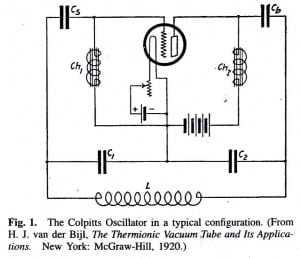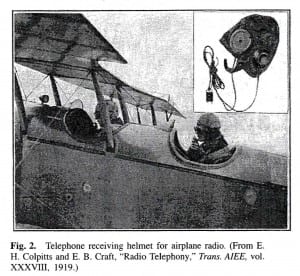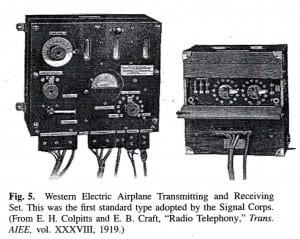History of Electrical Engineering
Scanning the Past: A History of Electrical Engineering from the Past
Submitted by Marc Bell, Editor
Copyright 1997 IEEE. Reprinted with permission from the IEEE publication, “Scanning the Past” which covers a reprint of an article appearing in the Proceedings of the IEEE Vol. 85, No. 6, June 1997.
 Edwin H. Colpitts, a communications engineer and research manager, was born 125 years ago this year. Remembered especially as the inventor of the Colpitts oscillator, he made significant contributions to both wire and radio telephony.
Edwin H. Colpitts, a communications engineer and research manager, was born 125 years ago this year. Remembered especially as the inventor of the Colpitts oscillator, he made significant contributions to both wire and radio telephony.
Born in 1872 in New Brunswick, Canada, Colpitts graduated from Mount Allison College in 1893. After two years as a teacher and school principal in Newfoundland, he enrolled at Harvard University, where he studied physics and mathematics and received a Master’s degree in 1897. He remained at Harvard for two additional years while taking advanced courses and serving as a laboratory assistant to John Trowbridge, director of the Jefferson Physical Laboratory.
Early in 1899, Colpitts joined the engineering staff of the American Bell Telephone Company in Boston, MA, where he began as an assistant to George A. Campbell, known for his work on loading coils and electric wave filters. Colpitts designed a variable-frequency generator for use in research on telephonic transmission and also carried out an investigation of dielectrics for capacitors. He did both theoretical and experimental work related to the proper loading of telephone circuits to minimize distortion and attenuation. Subsequently, he undertook a comprehensive series of tests intended to reduce crosstalk by the transposition of wires in contiguous circuits.
In 1907, Colpitts was transferred to the Western Electric Company in New York City, and in 1911, he was selected to head a research group. He and his colleagues began work on applications of the vacuum tube, including a push-pull amplifier and a modulator circuit, which he designed. The Colpitts modulator enabled signals sent by wire to control a radio transmitter at a remote location. Early in 1915, Colpitts proposed an oscillator circuit using capacitive coupling (Fig. 1) as an alternative to the inductive coupling used by the oscillator invented by a colleague, Ralph Hartley. The Bell engineers demonstrated transatlantic radio telephony using a vacuum-tube transmitter during 1915.
 Colpitts served in the Signal Corps of the U.S. Army during World War I and spent some time in France as a staff officer concerned with military communication (Fig. 2). He authored a joint paper with Edward B. Craft on radio telephony published in the Transactions of the American Institute of Electrical Engineers (AIEE) in 1919. The paper reviewed developments over the previous five years, including military radio equipment introduced during the war (Figs. 3, 4, and 5). Colpitts and Craft wrote that “the possibility of communication by speech between any two individuals in the civilized world is one of the most desirable ends for which engineering can strive.” They
Colpitts served in the Signal Corps of the U.S. Army during World War I and spent some time in France as a staff officer concerned with military communication (Fig. 2). He authored a joint paper with Edward B. Craft on radio telephony published in the Transactions of the American Institute of Electrical Engineers (AIEE) in 1919. The paper reviewed developments over the previous five years, including military radio equipment introduced during the war (Figs. 3, 4, and 5). Colpitts and Craft wrote that “the possibility of communication by speech between any two individuals in the civilized world is one of the most desirable ends for which engineering can strive.” They compared wire and radio telephony and included some advantages and limitations of each system (Fig. 6).
compared wire and radio telephony and included some advantages and limitations of each system (Fig. 6).
Colpitts and Otto B. Blackwell published an important paper on carrier multiplex telephony and telegraphy in the Transactions of the AIEE in 1921. They summarized work on bandpass filters and vacuum-tube electronics, which had enabled a four-channel commercial system to be placed in operation between Baltimore, MD, and Pittsburgh, PA, in 1918. They stated that the carrier method of multiplexing was “technically one of the most interesting and important of the developments which have been perfected in the art of electrical communications during the past few years.” They observed that Campbell’s band filters had been of “vital importance in the success of carrier telephone systems,” while the thermionic vacuum tube had provided a way to overcome many barriers to commercial systems. They  concluded that the technique used was “fascinating” but “to. the engineer, the economics of the situation are all important, for it avails nothing if it is not possible to accomplish by the new method the same or better results than were obtainable with the old at no greater
concluded that the technique used was “fascinating” but “to. the engineer, the economics of the situation are all important, for it avails nothing if it is not possible to accomplish by the new method the same or better results than were obtainable with the old at no greater cost.”
cost.”
Colpitts was a vice-president at the Bell Telephone Laboratories at the time of hisretirement in 1937, but came out of retirement to work on the National Defense Research Committee on problems related to antisubmarine warfare during World War II. He died in 1949 at age 77.
James E. Brit tain
